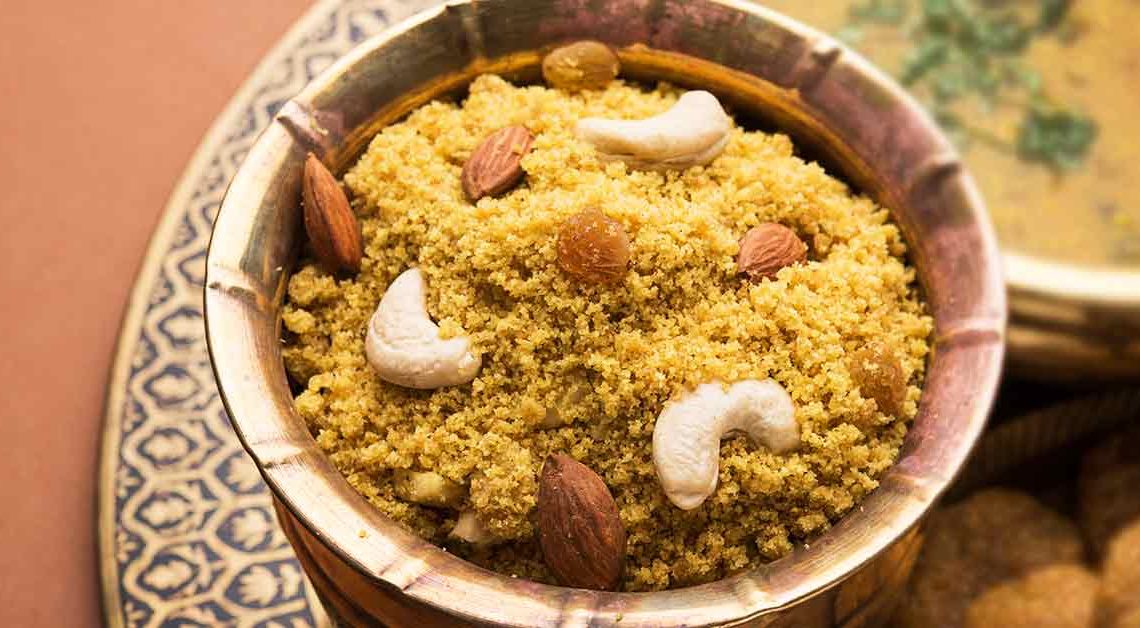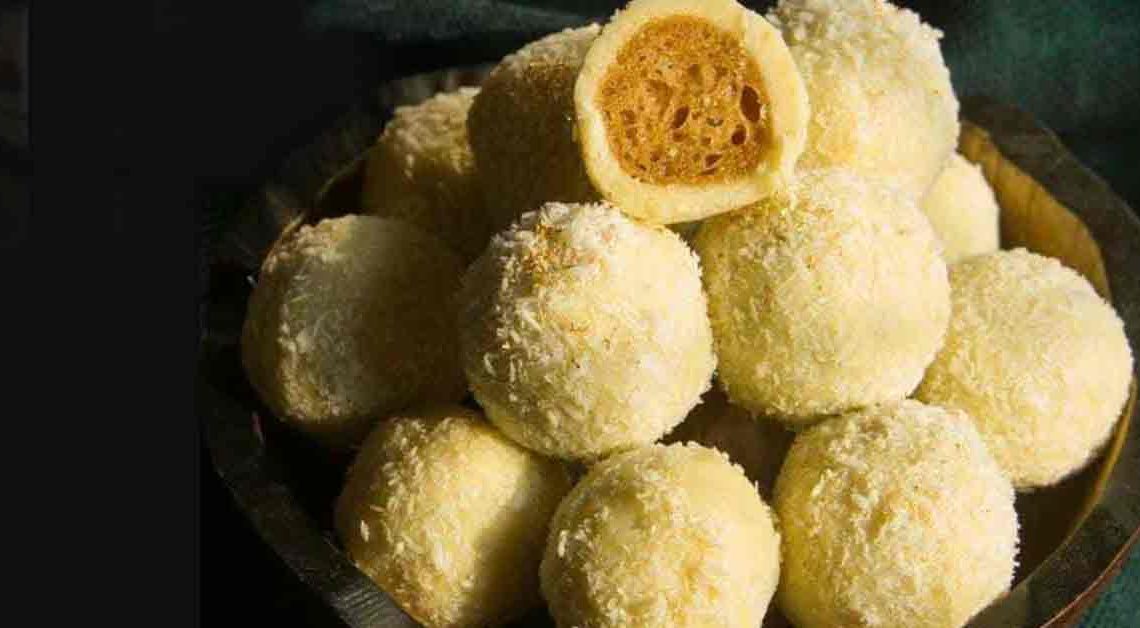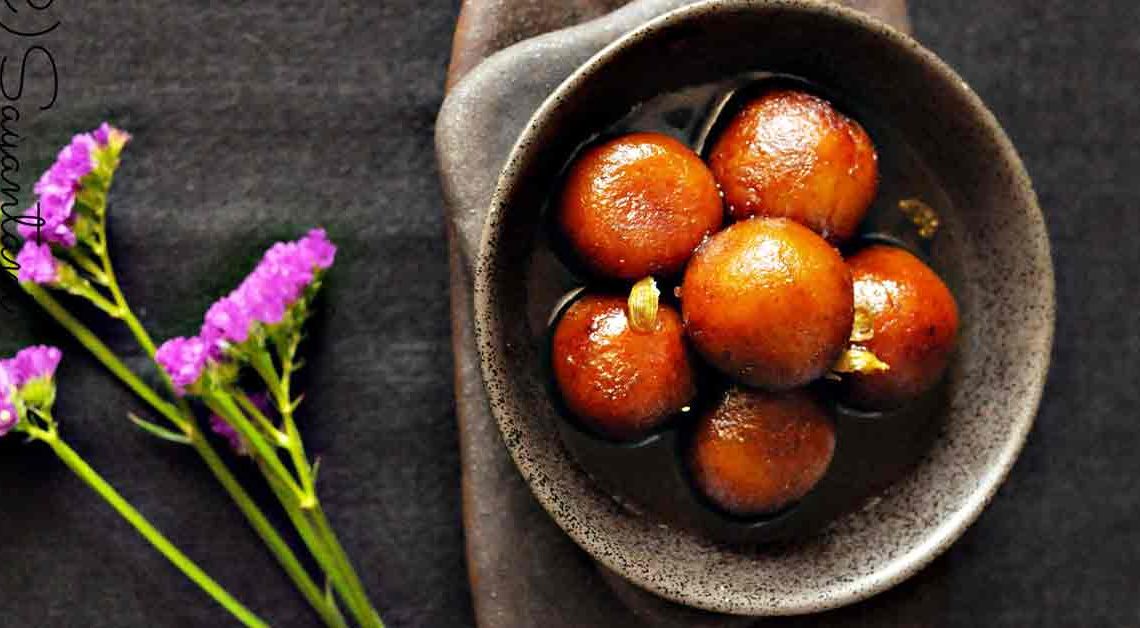Churma: A Sweet and Crispy Delight from Rajasthan

Welcome to Mithainama!, If you are looking for a dessert that is rich, delicious and easy to make, then you must try Churma, a traditional Rajasthani dish that is often served with Dal Baati. Churma is made by deep frying wheat flour dumplings and then grinding them into a coarse powder. The powder is then mixed with ghee, sugar, cardamom and nuts to make a sweet and crunchy mixture that melts in your mouth.
Churma has a long history in Rajasthan, where it is considered a staple food for the people living in the desert regions. It is said that Churma was invented by the wives of the soldiers who used to carry wheat flour, ghee and sugar with them during wars. They would fry the flour in ghee and make balls out of it, which they would later crumble and mix with sugar to make a filling and nutritious snack.
Churma can be made with different types of flours, such as besan (gram flour) or maize flour, but the most popular one is wheat flour. You can also add semolina (rava) to the flour to give it a more crispy texture. Churma can be shaped into laddus or served as a loose powder. You can also add dry fruits like almonds, pistachios, cashews or raisins to enhance the flavor and nutrition of Churma.
Churma is not only a dessert but also a symbol of love and hospitality in Rajasthan. It is often prepared on festivals and special occasions to celebrate with family and friends. It is also offered to guests as a sign of respect and warmth. Churma is a dish that can be enjoyed by everyone, young and old, as it has a simple yet satisfying taste that appeals to all.
If you want to experience the authentic taste of Rajasthan, then you must try Churma at least once in your life. You will surely fall in love with this sweet and crispy delight that will make you feel happy and content.
Origin of Churma
The word Churma comes from the Hindi word churana, which means to crush or grind. Churma is essentially made by grinding deep fried or baked wheat flour dumplings into a coarse powder and then mixing it with ghee, sugar and cardamom. Sometimes, other flours like besan (gram flour) or maize flour are also used to make Churma.
The origin of Churma can be traced back to the ancient times when Rajasthan was ruled by various clans and kingdoms. According to one legend, Churma was invented by accident when a cook of Mewar’s Guhilot clan poured sugarcane juice into some baatis (wheat flour dumplings) that he had prepared for the soldiers. He realised that the juice had made the baatis softer and sweeter, and decided to serve them to the king. The king liked the dish so much that he named it Churma and made it a part of his royal cuisine.
Another legend says that Churma was originally a wartime meal for the Rajput soldiers who used to carry wheat flour, ghee and sugar with them during battles. They would make baatis by burying the flour balls under the sand and letting them bake under the sun. When they returned from the war, they would crumble the baatis and mix them with ghee and sugar to make a filling and nutritious snack.
History of Churma
Churma became popular among the common people as well, especially in the desert regions of Rajasthan where water was scarce and wheat was the staple crop. Churma provided energy and warmth to the people who had to endure harsh climatic conditions. It also became a festive dish that was prepared on occasions like Makar Sankranti and Diwali.
This sweet was also influenced by the arrival of other cultures and cuisines in Rajasthan. For example, when the Gupta Empire extended its rule to Mewar, they brought along their love for panchmel dal, a mixture of five lentils cooked with spices. This dal was paired with baati and churma to make a complete meal. Similarly, when the Mughals invaded Rajasthan, they introduced dry fruits and nuts like almonds, pistachios, cashews and raisins that were added to churma to make it more rich and flavourful.
Churma has also been a part of many folk songs and stories that depict the life and culture of Rajasthan. For example, there is a famous folk song called “Chirmi” that describes how a girl makes churma for her beloved who has gone to fight in a war. The song expresses her longing and hope for his safe return.
The Sweet has also evolved over time and adapted to the changing tastes and preferences of the people. For example, some people prefer to use jaggery instead of sugar as a sweetener for churma. Some people also add semolina (rava) to the wheat flour to give churma a more crispy texture. Some people also experiment with different flavours and ingredients like chocolate, fruits, saffron, nutmeg, etc. to make churma more interesting and delicious.
Cultural Significance
Churma is not just a food item but also a symbol of love, hospitality and tradition in Rajasthan. It is often prepared by women as a gesture of affection and respect for their husbands, sons, brothers and guests. It is also offered to gods and goddesses as a form of prasad (offering) in temples and homes.
The sweet is also associated with various rituals and customs in Rajasthani culture. For instance, it is customary for a newly married bride to prepare Churma for her in-laws as a way of impressing them and seeking their blessings. It is also considered auspicious to feed Churma to cows on certain days as a way of showing gratitude to nature3.
Churma is also a part of many folk songs and stories that depict the life and culture of Rajasthan. For example, there is a famous folk song called “Chirmi” that describes how a girl makes Churma for her beloved who has gone to fight in a war. The song expresses her longing and hope for his safe return.
Where is Churma Famous?
Churma is famous all over Rajasthan, especially in regions like Mewar, Marwar, Shekhawati and Hadoti. It is also popular in neighbouring states like Gujarat, Madhya Pradesh and Uttar Pradesh where it is prepared with slight variations. For example, in Gujarat, Churma is made with jaggery instead of sugar and flavoured with sesame seeds. In Madhya Pradesh, Churma is made with semolina (rava) instead of wheat flour. In Uttar Pradesh, Churma is made with khoya (milk solids) instead of ghee.
Churma has also gained popularity in other parts of India due to its availability in restaurants and sweet shops that serve Rajasthani cuisine. Many people enjoy Churma as a dessert or a snack that can be eaten anytime of the day.
Facts and Trivia
- It is often shaped into laddus (round balls) that can be stored for a long time and eaten as a convenient snack. The laddus are sometimes decorated with silver foil (varak) and dry fruits to make them more attractive and festive.
- It can be made with different types of sweeteners like sugar, jaggery, honey, dates, etc. depending on one’s preference and availability. Some people also add spices like saffron, nutmeg, cinnamon, etc. to enhance the flavour and aroma of the sweet.
- It can be eaten with different types of accompaniments like dal, curd, buttermilk, milk, etc. depending on one’s taste and mood. Some people also like to eat Churma with pickle, chutney or salad to balance the sweetness and add some tanginess to the dish.
- It is considered a healthy dish as it is rich in carbohydrates, proteins, fats, fibre, minerals and vitamins. It also provides instant energy and warmth to the body and helps in digestion. However, it should be eaten in moderation as it is also high in calories and cholesterol.
- It is a versatile dish that can be experimented with different ingredients and flavours. For example, one can make chocolate Churma by adding cocoa powder and chocolate chips to the wheat flour mixture. One can also make fruit Churma by adding chopped fruits like apple, banana, mango, etc. to the crumbled baatis.
Did you know?
Churma is a sweet dish made from crumbled wheat flour dumplings mixed with ghee, sugar and nuts. It is a traditional delicacy from Rajasthan that is often served with Dal Baati, a savoury dish of lentils and baked wheat balls.
The sweet can provide you with many benefits, such as:
- It is rich in carbohydrates, proteins, fats, fibre, minerals and vitamins that can nourish your body and boost your immunity.
- It can provide you with instant energy and warmth as it is made with ghee, which is a good source of calories and healthy fats.
- It can help in digestion as it contains wheat flour and nuts that are high in fibre and can prevent constipation and bloating.
- It can also satisfy your sweet tooth and make you feel happy and content as it contains sugar and cardamom that can enhance your mood and reduce stress.
However, this sweet should be eaten in moderation as it is also high in calories and cholesterol. It should be balanced with other healthy foods and physical activity to maintain your overall health and wellness.







